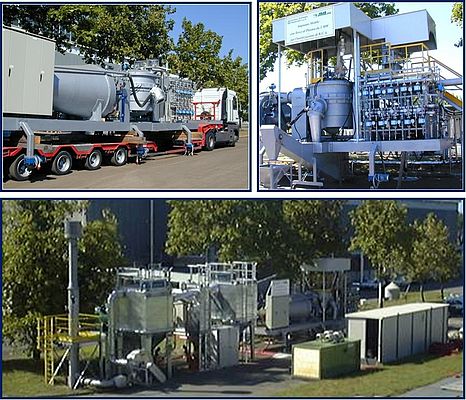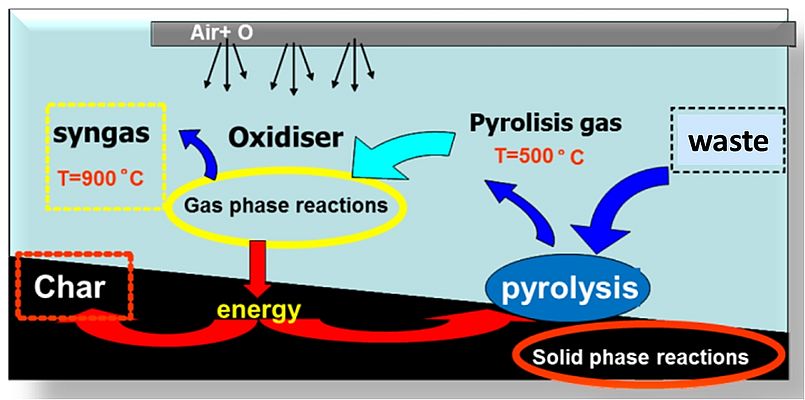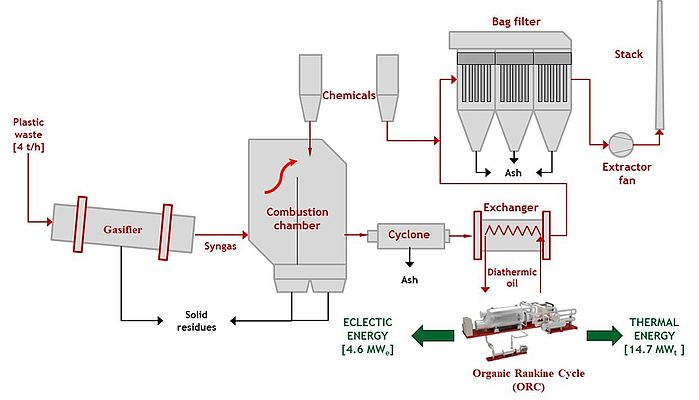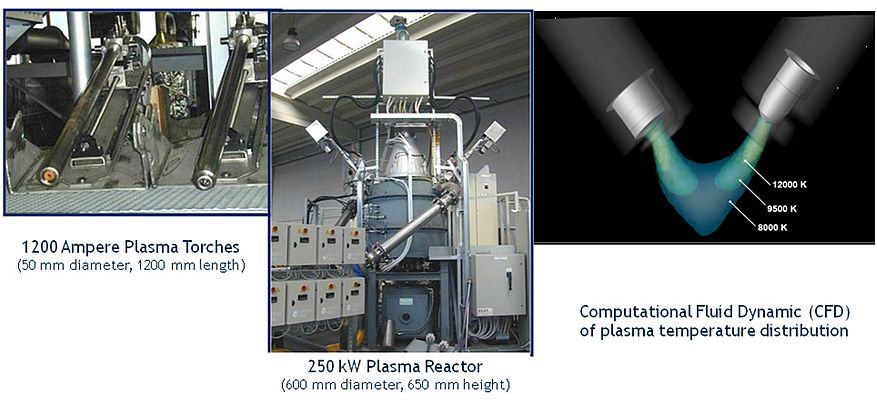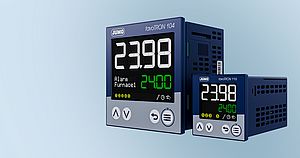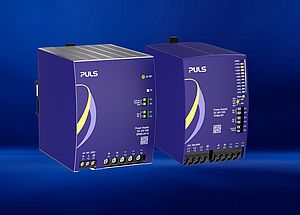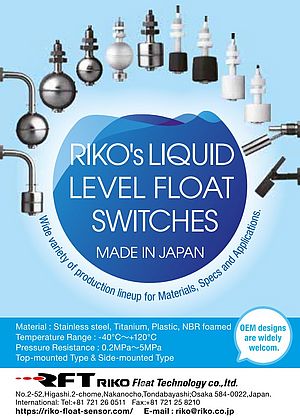CSM pyro-gasification technology
In the case of solid materials with calorific value the main path is syngas production. CSM has chosen pyro-gasification, as the process for the valorization of waste as energy. Whenever waste inlets to the reactor the organic matrix produce a syngas that allows to self-sustain the process, while the surplus can be exploited in a downstream process efficiently or can be stored to be consumed away from the production site. The CSM reactor scheme (figure 3) takes the advantages of both the rotary kiln (handling of variable materials) and of the fluidized bed (high residence time and good mixing) resulting in high efficiency in C transformation even at low temperatures <600 °C.
The distribution along the reactor of the oxidizer (patented) is the key for the control of process temperature and a proper mixing between the gaseous and solid phase. In such a way the pyrolysis section of the reactor allows an efficient heating of the input material, dehydrating and pyrolysis the waste (eliminating most volatile organic). The option of indirect heating using hot waste gas recirculation, has been also studies and integrated in the pyrolysis section for the waste with high percentage of humidity, such as sludge. In case of waste with low reactivity the material coming from the pyrolysis section (char), enters a second section of the reactor in which an additional quantity of oxidizer (air, oxygen and / or vapor or their mixture) can be used.
This approach allow to adapt the CSM pyro-gasification technology to the characteristics of the different wastes (quantity and quality) and the final use (destination) of the syngas. During the last ten years, CSM has realized and tested different pyro-gasification prototype plants, up to 100 kg /h (figure 4), that enable refinement of mass and energy balances for a scaled-up industrial plant and for more precise estimates of capital and operating costs.
An example of a solution developed by CSM consists in the plastic waste and automotive shredder residue (ASR) transformation into resources. Experimental campaigns were conducted at CSM on a pilot plant with a capacity to treat 100 kg/h of waste: the composition of a typical plastic waste and of the syngas produced are reported respectively in figure 4.
The syngas can be used in several different ways: the choice depends on the characteristics of the installation site and on the specific user requirements. For example, in the case of a plant installed far away from existing industries and for users who prefer simple, compact and easily managed plants, a good solution is to use an ORC (Organic Rankine Cycle) to produce both electrical and thermal energy (figure 5). On the other hand, a gasifier plant can be integrated into an existing industrial facility (for instance a chemical or petrochemical plant) where the syngas can be directly utilized in existing processes.
CSM plasma torches
The plasma torches reactor developed by the CSM is based on the principle of "Twin torch" (anode and cathode transferred arc) and use of Argon as plasmogenic media. This technology (figure 6) has been developed for hazardous waste (organic or inorganic as PCB, asbestos, fly ash from thermal treatment). Plasma torches are very high density energy and high temperature systems (7000-10000 °C) and are fed with electrical energy and low flow rate of inert process gas. An electric field and passage of current produce an ionization of the injected gas and volatile part of waste which result in the breaking of molecular and atomic bonds. The high temperature obtained in the reactor allows the melting of materials treated and the subsequent inert residue and the desired particle size, suitable for new uses (figure 7).
CSM innovation effort has been concentrated mainly in developed and optimized of transferred Arc Plasma Torches also by means of the CFD (Computational Fluid Dynamics) modelling and in increasing thermal efficiency. Through optimization of the original prototype the current configuration (CSM proprietary technology) permits the reduction of the thermal losses both related to the very low gaseous flow (<0.1 Nm3/h kg of Argon) and the optimization of the cooling circuit. , reaching significant lengthening of the life time of the torches, such as to make it compatible with a normal industrial maintenance.
Several prototypes of plasma torches have been built (also transportable on skid), adapting the entire structure of the plant to the type and quantity of waste requirements by end customer. The first industrial reactors (until power of 0.5 MW, figure 8), based on the CSM patented technologies, has been designed for Italian companies.
Waste management: a local challenge with a global impact
Increasingly, pressing regulations from almost all over the world demand that industries, communities and municipalities proactively deal with waste in a different manner than in the past. In particular the full compliance with the principle of self-sufficiency and self-management of waste, in the area from which they are originate responds to the most modern ethical criteria of "global responsibility" of the waste producer and should also support the reduction of trans-boundary shipments of waste due to volatile in prices and taxes for treatment or disposal.
New approaches to waste management are however necessary to make possible to transform waste problem into an economic opportunity with profitable revenues from material and energy recovery, while reducing or eliminating, at the same time, disposal costs and social impacts. Moreover the proposed approach must target reduce the negative perception of public opinion respect to the big waste treatment installations implementing the capability to:
- recover and use the energy from waste
- minimize the formation of macro (acids, dust, heavy metals) and micro-pollutants (dioxins and furans) at the chimney
- obtain, from inert fraction of the waste, secondary raw material to be used for other industrial applications (e.g. building material).
The rotary kiln gasifier with distributed injection and the transferred arc plasma torches developed by CSM, applied successfully for treatments on several types of waste with experimental campaigns carried out on 50-100 kg/h pilot plants, have the potential to reach these targets. Integration of these technologies in commercial scale plants to produce syngas enables effective solutions for addressing challenges of future waste management regulatory requirements. The efficiency and reliability achieved by these technologies allow them to be particularly well suited for waste streams with intrinsic calorific content, but also with highly polluting substances like heavy metals and dioxins. Combining the rotary kiln gasifier with the transferred arc plasma torches for the inertization of possible dangerous solid residues from gasification treatment enables solution with close to zero waste. The scaling up of the technologies developed is in progress with the target to build plants of 30.000-40.000 t annual capacity.



